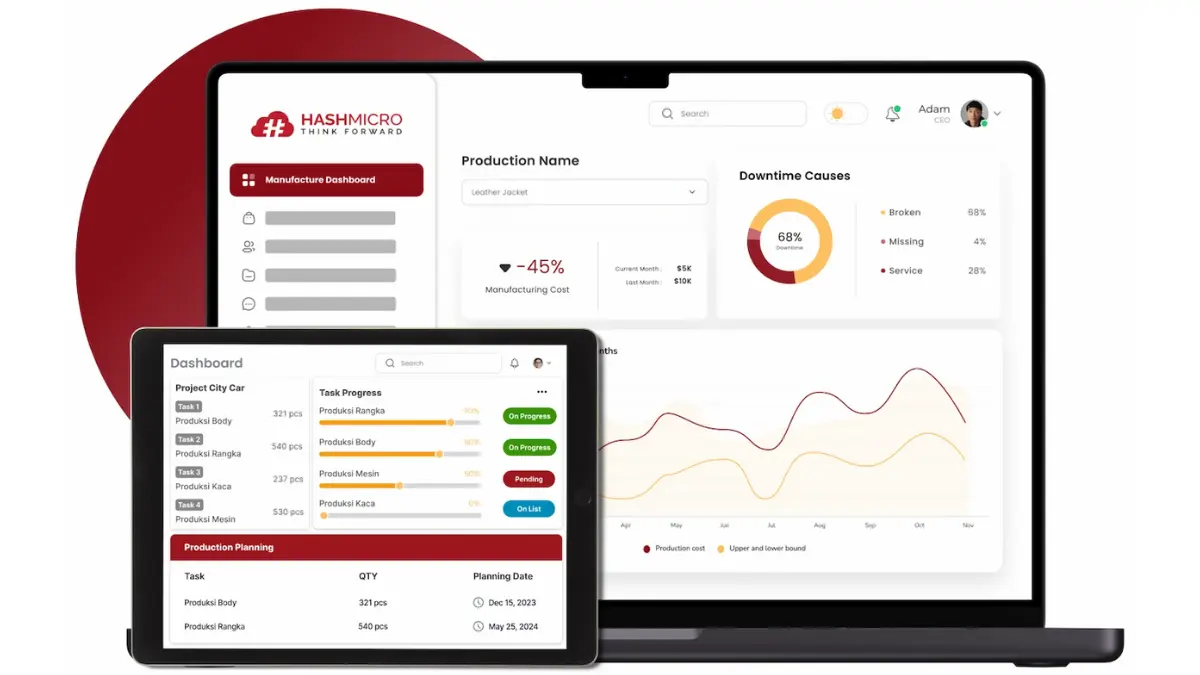Slow-moving inventory is more than just excess stock; it’s tied-up capital that limits growth and warehouse efficiency. As a business owner, I’ve seen how proactive management can make all the difference in keeping operations agile and profitable.
In Singapore’s competitive market, effective inventory management is key to sustaining profitability and operational efficiency. This aligns with findings from the Singaporean Journal of Business Economics and Management (JBEM), which reveal that strong inventory practices significantly enhance efficiency and customer satisfaction.
That’s why I recommend HashMicro Inventory Management Software, which offers real-time tracking, automated stock alerts, and analytics to improve turnover and reduce costs. Try the free demo today and see how it transforms your operations.
Key Takeaways
|
What is Slow-Moving Inventory?
Slow-moving inventory is stock items, whether raw materials or finished goods, that face low demand over an extended period, generally lasting six months or more. These products build up in storage due to slow sales, resulting in longer-than-expected time in inventory.
This type of inventory often ties up valuable resources in terms of capital and storage space. Companies may struggle to manage excess stock, increasing holding costs and negatively impacting overall cash flow.
Businesses that use tools such as cloud-based inventory solutions gain better visibility into their stock levels and can identify slow-moving items early, allowing for proactive management and reducing the risk of excess stock buildup.
The Difference Between Slow-Moving and Obsolete Inventory

Slow-moving inventory refers to products that remain in stock for an extended period but still have the potential to be sold. These items may not move as quickly as anticipated, but they can still generate revenue with the right strategies, like promotions or markdowns.
On the other hand, obsolete inventory consists of items that are no longer in demand and unlikely to sell. This inventory often results from changes in market trends, technology, or product expiration, leading to a complete loss in value.
Understanding the difference between slow-moving and obsolete inventory is crucial for effective inventory management. While slow-moving stock can still offer opportunities with proper management, obsolete inventory usually requires immediate action, such as liquidation or write-offs, to minimize financial losses.
Why is Slow-Moving Inventory Problematic?
Slow-moving inventory can have far-reaching consequences for a business, impacting everything from cash flow to operational efficiency. Awareness of these impacts allows companies to address minor issues before they escalate into more significant problems.
- Tied-up capital: Lingering inventory ties up valuable capital, preventing businesses from investing in growth opportunities or addressing pressing financial needs. When money is locked in unsold stock, it limits a company’s liquidity and flexibility.
- Increased storage and carrying costs: Holding on to inventory for extended periods increases storage and insurance costs, which can eat into profit margins. If items require special conditions, like refrigeration or more warehouse space, the cost of carrying these products becomes even higher.
- Risk of losing value: The more extended inventory sits unsold, the greater the risk of it losing value, especially with perishable goods or rapidly changing trends. This leads to potential markdowns and may result in total product obsolescence, further draining profitability.
- Inventory loss and security risks: Prolonged storage increases the likelihood of loss due to theft, damage, or disasters like fires and floods. With slow-moving stock sitting in inventory, the financial impact of such losses can be much higher, particularly for valuable items.
- Underlying operational issues: Slow-moving inventory can signify larger, hidden problems such as ineffective demand forecasting or inefficient supply chain communication. Identifying the root cause of slow-moving stock is crucial to preventing future disruptions and optimizing business performance.
By utilizing tools like ERP systems, businesses can better track, forecast, and manage their inventory, minimizing the risks associated with slow-moving stock. HashMicro’s ERP solutions in Singapore are designed to help you overcome these challenges and streamline operations.
How to Identify Slow-Moving Inventory

Identifying slow-moving inventory is crucial for maintaining an efficient supply chain and optimizing storage costs. By recognizing these items early, businesses can prevent excess stock from tying up capital and resources.
Let’s explore key strategies for effectively identifying slow-moving inventory and taking proactive steps before it becomes problematic.
- Overstock management: Overstock occurs when a business holds more inventory than it can sell within a reasonable timeframe. Businesses can avoid excessive holding costs by using inventory tracking to identify slow-moving stock early.
- Inventory turnover rate: Inventory turnover reflects how frequently stock is sold and replaced over a period. A low turnover rate signals slow-moving stock, prompting timely action to address the issue.
- Shipment frequency optimization: Infrequent shipments suggest that a product is not selling well, indicating potential slow-moving or obsolete inventory. Leveraging inventory software allows businesses to monitor shipment trends and take corrective measures.
- Inventory holding costs: High holding costs indicate that products sit in the warehouse too long. Understanding the impact of slow-moving inventory on storage costs is essential for improving cash flow.
- Average days to sell inventory: This metric measures the time it takes to sell stock, helping identify slow-moving items. Recognizing products with longer sales cycles enables businesses to adjust their inventory strategy.
- Gross profit analysis: Low gross profit margins on certain products can indicate slow-moving inventory. Analyzing these margins allows businesses to make strategic pricing adjustments to boost sales.
- Inventory forecasting strategies: Accurate forecasting helps reduce the risk of slow-moving and obsolete inventory by aligning stock levels with market demand. Implementing inventory management software can improve forecasting and optimize stock management.
What to Do with Slow-Moving Inventory?

Dealing with slow-moving inventory is crucial to maintaining a healthy cash flow and reducing excess storage costs. By addressing the issue proactively, businesses can prevent stock from becoming obsolete and minimize financial losses.
Let’s explore some practical strategies to manage and move slow-moving inventory efficiently.
1. Optimize your marketing strategies
First, evaluate your current marketing strategies to identify which ones are effective and which need improvement. Comprehensive inventory software can help you meet inventory demand while refining your marketing approach.
Update your product photos on your e-commerce site to ensure they appeal to potential buyers. With integrated inventory software, you can monitor stock movements and effectively re-market products through social media or email campaigns.
2. Use multiple sales tactics
Employing multiple sales tactics is crucial to manage consignment stock and maximize sales. These strategies help clear out slow-moving inventory and create opportunities to attract new customers and retain existing ones.
By combining different sales approaches, businesses can enhance their overall sales performance and maximize seasonal and time-limited opportunities. Here are a few sales tactics you can use:
- Clearance sales: You can hold clearance sales twice a year to clear out any stock that hasn’t sold in the past 3-6 months. Use social media to let people know about the big sale day. Remember to remind your existing customers to come by email or SMS.
- Flash sales: Flash sales can give consumers a serious FOMO (the fear of missing out) effect. Notify shoppers of your limited-time sale a few days before. Also, set up a banner on your website to create urgency.
- Seasonal sales: Holidays are the right time for you to sell your slow-moving inventory to discount seekers. Pack your products as attractively as possible and adjust them to the season. For example, if you are going to sell your product on Christmas Eve, you can decorate it with red ribbons.
3. Transform your store displays
Changing your store displays can help consumers pay more attention to your products. They may not have been aware of your slow-moving items because they are not in strategic areas of your store.
You can put them near the cashier, on the front shelves, or in places that customers will see and pass through. You can also use a facility management system to simplify your facility management and maintenance process.
4. Bundle your products
Another effective way is to bundle your slow-moving products with the fast-moving ones. Shoppers will be interested in buying product bundles because they are more attractive than those sold separately.
Also, consider combining high-margin products with lower-margin ones. If you have too many slow-moving items, you can combine them into one discounted package.
5. Optimize your inventory management
You certainly don’t want to keep storing many slow-moving items in your store. If you keep them for too long, they could easily get damaged, making them unsuitable for sale. Thus, regular inventory tracking is essential to help you take immediate action to manage slow-moving inventory.
Inventory management software can help you easily determine which products sell best and which ones do not across multiple stores. It can also help you forecast customer demand at any time, keeping your inventory under control and avoiding unnecessary procurement that does not benefit your business.
Curious to explore how inventory management software can streamline your inventory control and bolster your business? Click the banner below to explore tailored pricing schemes for enhanced inventory management!
6. Forecast demand
Forecasting demand is essential for managing slow-moving stock. It analyzes historical sales data and market trends to predict future demand. This insight helps businesses anticipate shifts in consumer behaviour, preventing overstocking or understocking of slow-moving items.
In Singapore, accurate demand forecasting allows companies to align production and procurement with expected sales, reducing the risk of excess inventory. It also supports proactive strategies like targeted promotions to boost demand for stagnant products, optimizing overall inventory management.
7. Leverage sales channels
Exploring new sales channels, like partnering with online platforms, can help reach diverse customers. By leveraging partnerships and using moving inventory software, businesses can access broader markets and move inventory that isn’t selling well in their primary outlets more effectively.
8. Offer promotions or discounts
Temporary promotions, such as “Buy one, get one free,” can increase the appeal of slow-moving stock without setting a permanent price cut precedent. Just ensure that profit margins can withstand the increased volume from customers seizing these deals.
Examples of Slow-Moving Inventory
Slow-moving inventory refers to items that experience low sales over an extended period and typically remain in stock longer than anticipated. These products may tie up capital and storage space, leading to higher business costs.
Below are some common examples of slow-moving inventory:
1. Seasonal products: Products like holiday decorations or winter clothing that only sell well during specific seasons can become slow-moving once the season ends.
2. Outdated technology: Older electronics, such as outdated smartphone models or obsolete computer components, become slow-moving when new versions are released.
3. Niche products: Items that cater to a specialized or limited market, like custom machinery parts or rare books, often experience slower sales due to their narrow target audience.
4. Luxury goods: High-end products such as designer handbags or luxury watches may move slowly due to their higher price points and limited customer base.
5. Overstocked items: Excess inventory caused by inaccurate forecasting or over-purchasing can become slow-moving, as demand does not match the available supply.
5 Ways to Prevent Slow-Moving Inventory

Effective inventory management is crucial for maintaining optimal cash flow and reducing storage costs. Implementing proactive strategies can prevent the accumulation of slow-moving stock.
Here are five methods to enhance inventory turnover and boost profitability.
- Forecast demand: Accurate demand forecasting helps businesses anticipate sales drops and adjust inventory levels accordingly. For instance, if weather predictions hint at a mild winter, use historical data to avoid overstocking slow-moving items like heavy winter coats.
- Early warning systems: Implementing an early warning system allows businesses to identify potential slow-moving stock before it crosses the threshold. By monitoring product metrics closely, companies can take preventative actions when they see signs of items lingering in stock longer than usual.
- Supply chain communication: Effective communication with suppliers and customers enables businesses to adapt quickly to market changes. For example, if a major customer foresees a decrease in demand, notifying suppliers promptly can prevent unnecessary stock build-up and potential slow-moving stock.
- Monitor the competition: Monitoring competitors’ promotions and new product launches helps businesses respond proactively to market changes. Subscribing to competitor newsletters is an easy way to gather real-time information, allowing you to adjust strategies before you face the problem of slow-moving and obsolete inventory.
- Inventory management software: Advanced moving inventory software provides real-time insights into sales trends and inventory status. This technology helps identify slow-moving stock early, enabling businesses to make informed adjustments to supply levels before they become a significant issue.
Enhance Slow-Moving Inventory Sales with HashMicro Inventory Management Software

HashMicro’s Inventory Management Software is one of the best solutions for managing slow-moving inventory. With its advanced features, HashMicro has become a trusted choice for various companies in Singapore, thanks to its excellence in inventory management.
If you’d like to explore the benefits of this software further, HashMicro offers a free demo to give you an in-depth understanding of how it can transform your business operations.
HashMicro provides several key features, such as:
- Fast Moving Slow Moving Stocks Analysis: This feature identifies fast- and slow-moving products, helping businesses optimize stock levels and cut storage costs.
- Stock Forecasting: Stock forecasting predicts future inventory needs to align stock levels with demand and prevent excess or slow-moving items.
- Stock Aging Report: This report tracks inventory age, helping businesses identify and act on aging stock before it becomes obsolete.
- Stock Optimizer per Warehouse: The stock optimizer ensures efficient inventory distribution across warehouses, balancing stock in real time to prevent the buildup of slow-moving items.
- FEFO—First Expiry First Out: FEFO ensures items with the earliest expiration are used first, minimizing waste and preventing slow-moving stock from expiring.
- Product Expiry Management: This feature alerts businesses to products nearing expiration, helping prioritize slow-moving stock to reduce losses.
- Stock Reservations & Reporting: Stock reservation tools allocate inventory for specific orders in real time, ensuring high-priority stock is always available.
- Replenishment of Product with Multiple Actions: This feature automates restocking based on demand trends, maintaining optimal inventory levels and preventing slow-moving stock buildup.
- Return Management: Return management streamlines product returns, ensuring items are quickly reassessed and restocked to prevent them from becoming slow-moving.
“Slow-moving inventory quietly drains capital and space. With real-time analytics, you can spot sluggish items early, adjust strategies, and free up cash flow.”
— Angela Tan, Regional Manager
Conclusion
Dealing with slow-moving inventory is a common challenge faced by retailers, demanding immediate attention. Employing varied strategies like optimizing marketing approaches and bundling products becomes imperative to drive profitability. Delays in addressing this issue can impede business processes significantly.
To resolve slow-moving inventory concerns effectively in Singapore, consider HashMicro’s Retail System. This innovative solution streamlines stock management, financial transactions, sales, marketing, customer relationships, and overall warehouse operations within a unified platform.
Leverage HashMicro’s Inventory Management System to seamlessly integrate inventory and marketing strategies for improved efficiency. Contact us today for pricing details and a free demo!
FAQ About Slow-Moving Inventory
-
Why is it essential to address slow-moving inventory?
Slow-moving inventory ties up capital occupies storage space, and can lead to potential obsolescence. Handling it efficiently is crucial to free up resources and maintain profitability.
-
How can businesses identify slow-moving inventory?
To identify slow-moving stock, analyze sales data regularly. Look for items with minimal sales over an extended period, typically 3-6 months. Consider using inventory management software to track sales performance comprehensively.
-
What are some effective tactics to manage slow-moving inventory?
Implement various sales strategies such as clearance sales, flash sales, or seasonal promotions to encourage sales. Consider bundling slow-moving items, transforming store displays, and optimizing marketing strategies to attract customer attention.
-
How can forecasting demand help in managing slow-moving inventory?
Forecasting demand involves analyzing historical sales data and market trends to predict future demand accurately. This strategy aids in planning inventory levels, preventing overstocking or understocking, thereby mitigating slow-moving stock issues
-
How important is communication within the supply chain when addressing slow-moving inventory?
Effective supply chain communication is vital. It enables sharing insights, forecasts, and market trends among stakeholders, aiding in adjusting production or orders promptly and preventing excessive stock buildup of slow-moving items.

































